


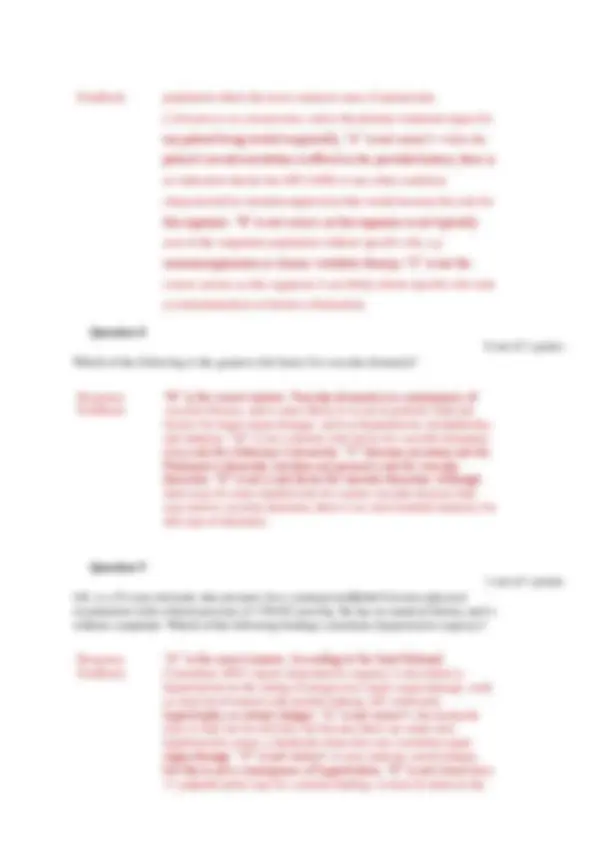
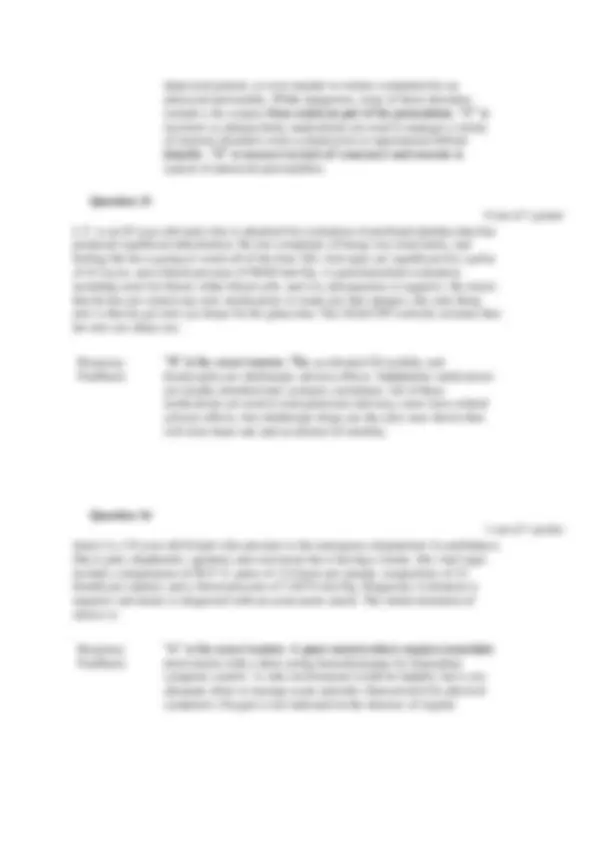
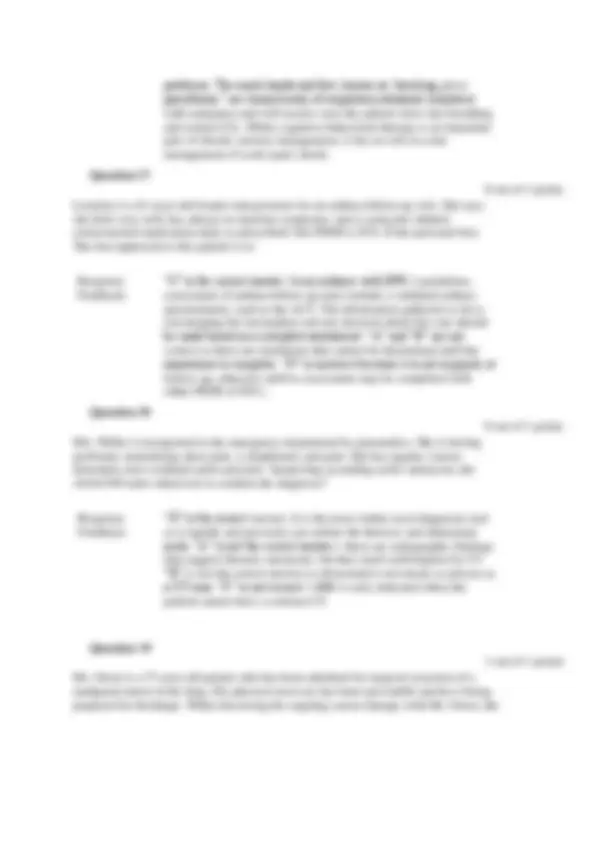
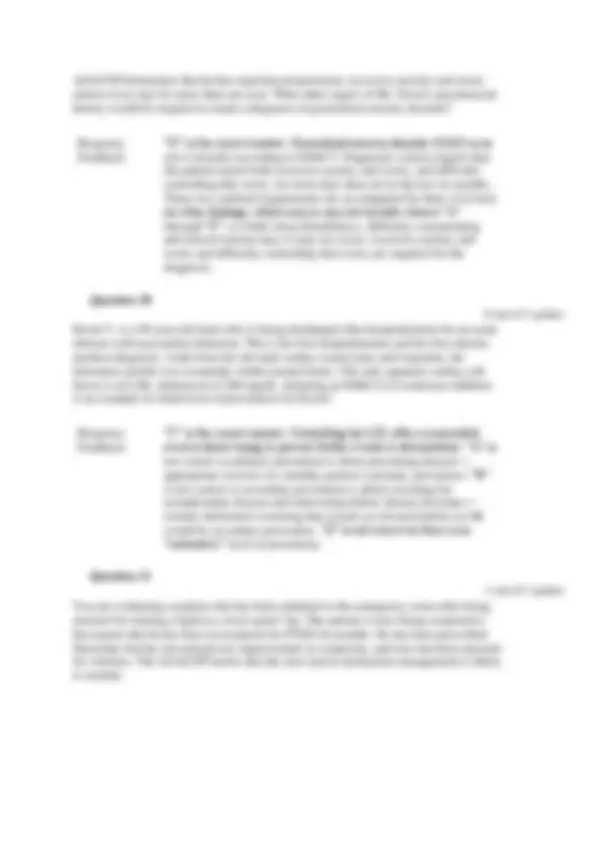
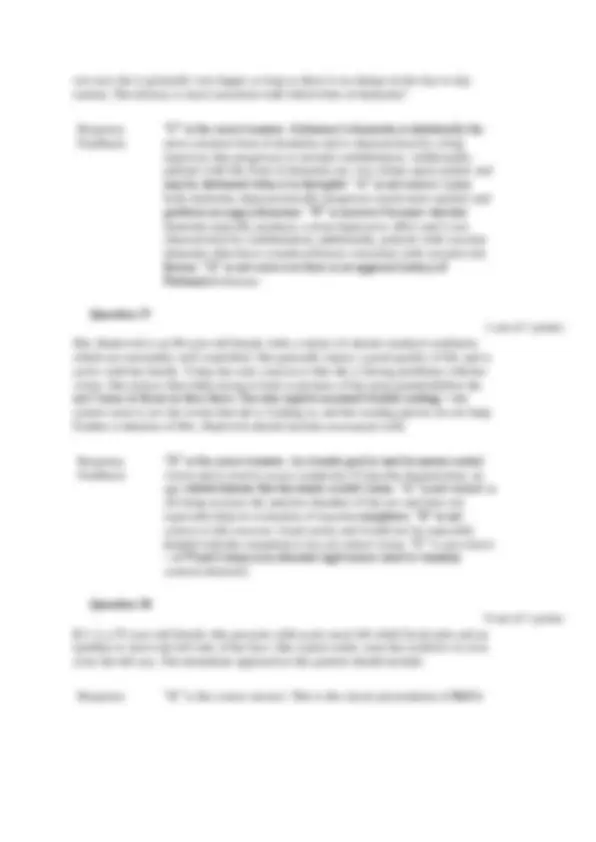
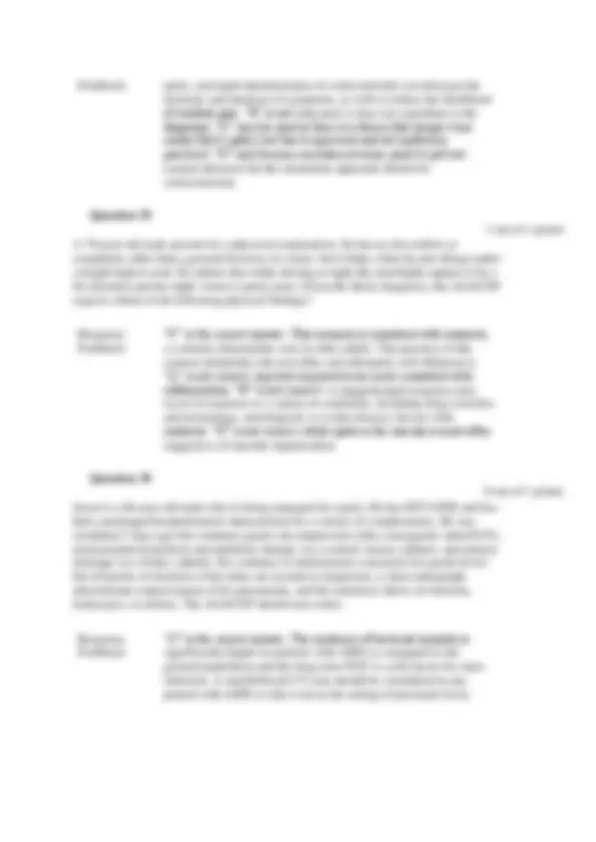
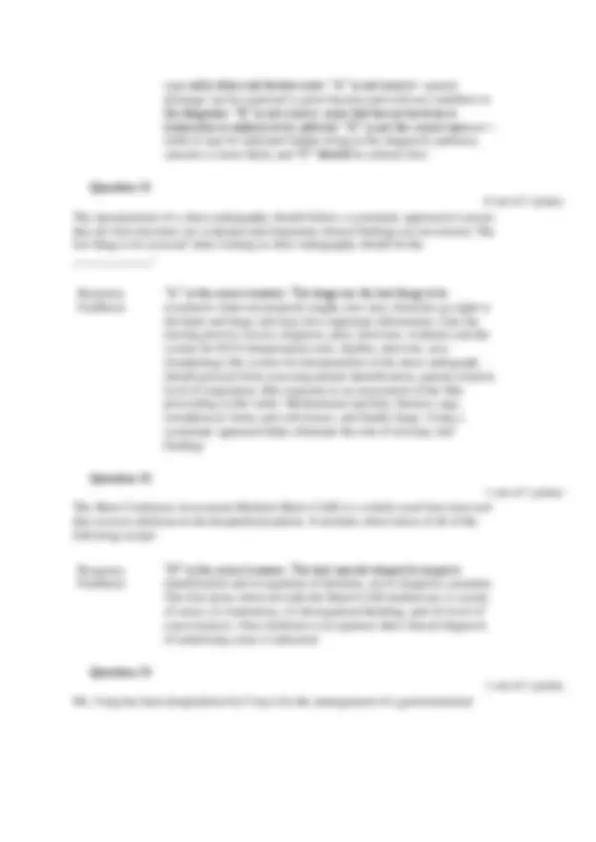
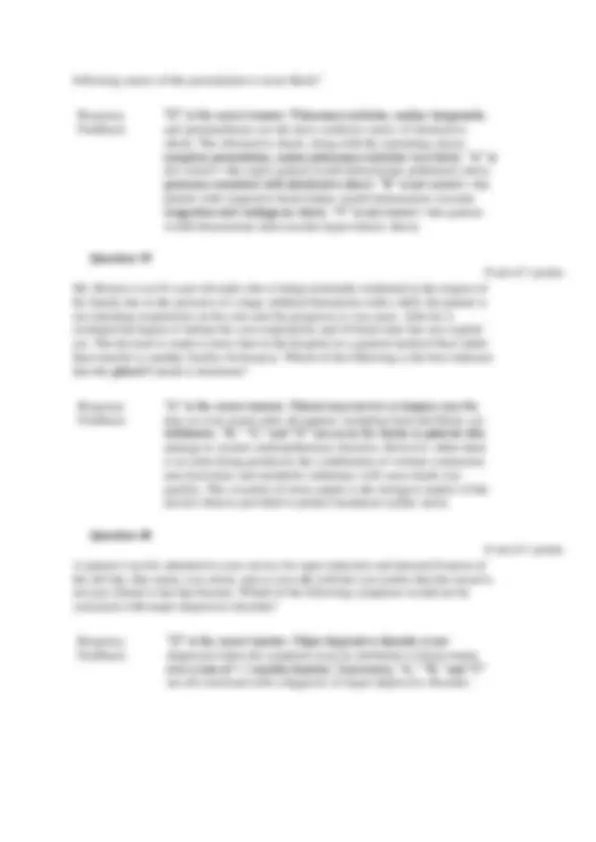
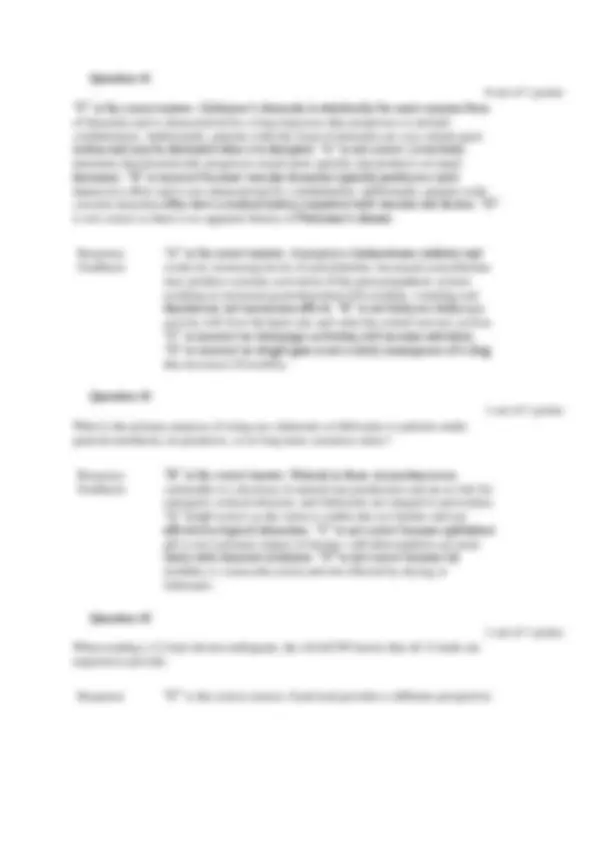
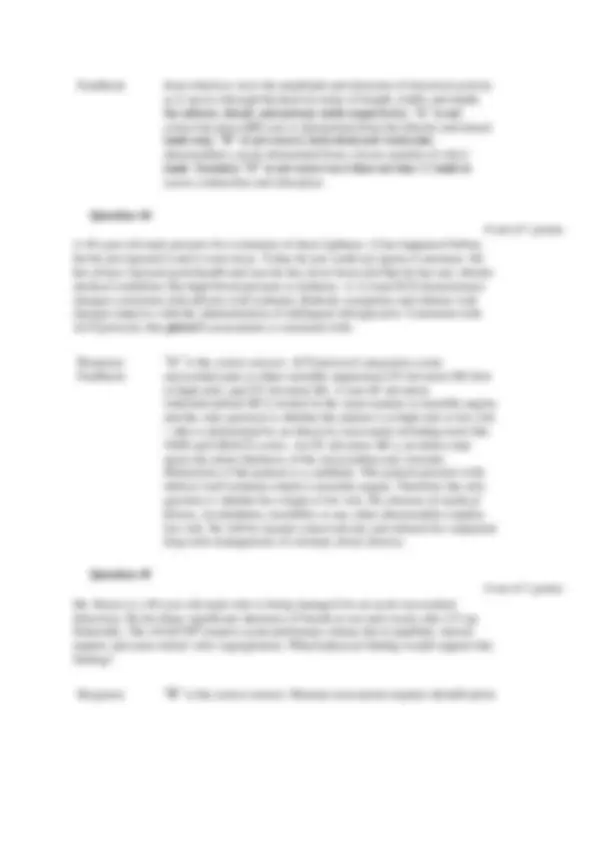
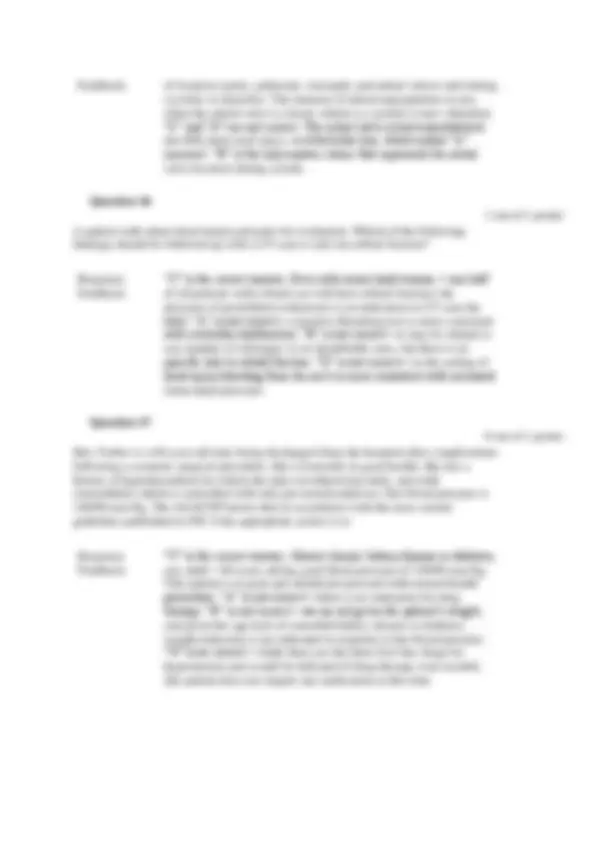
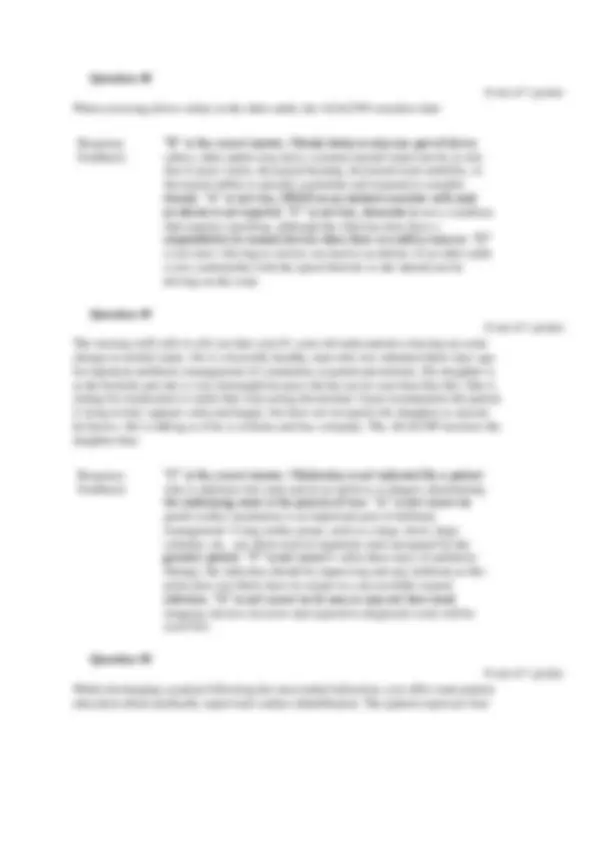
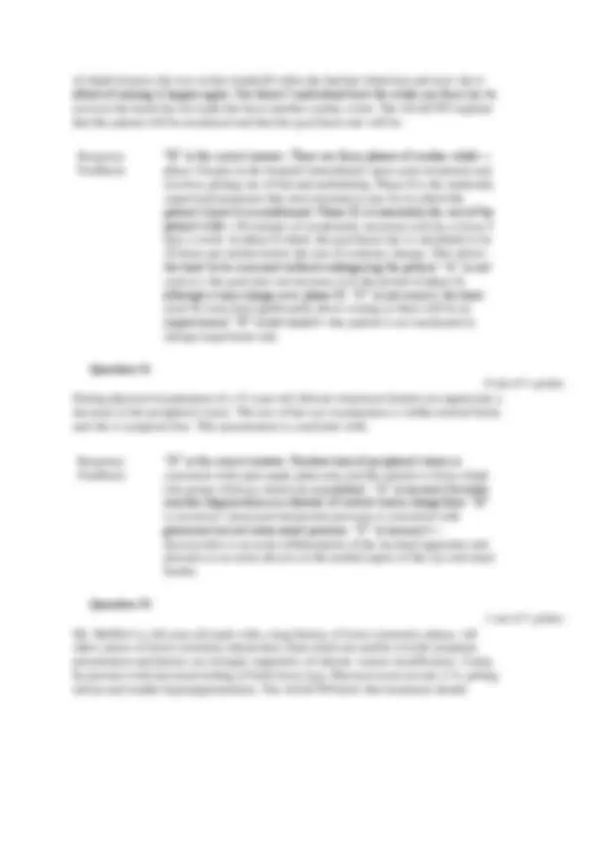
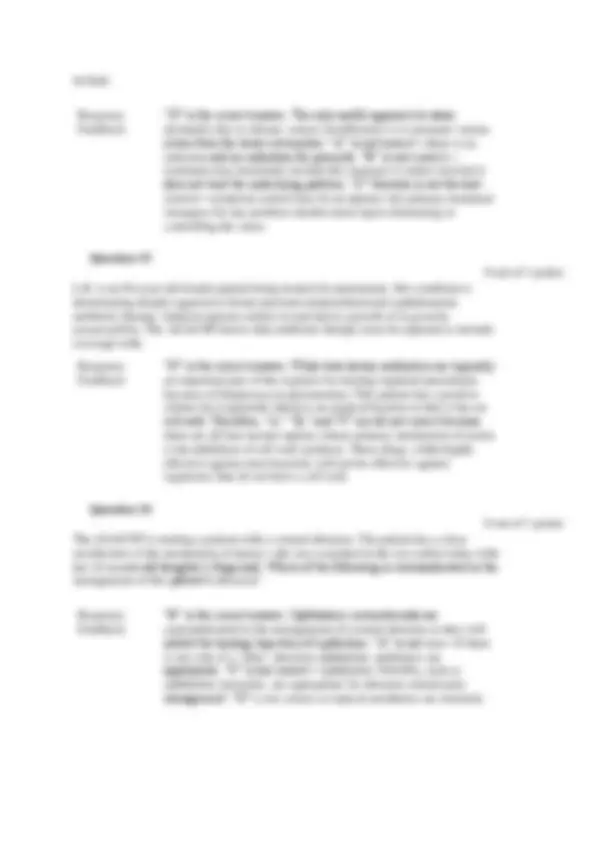
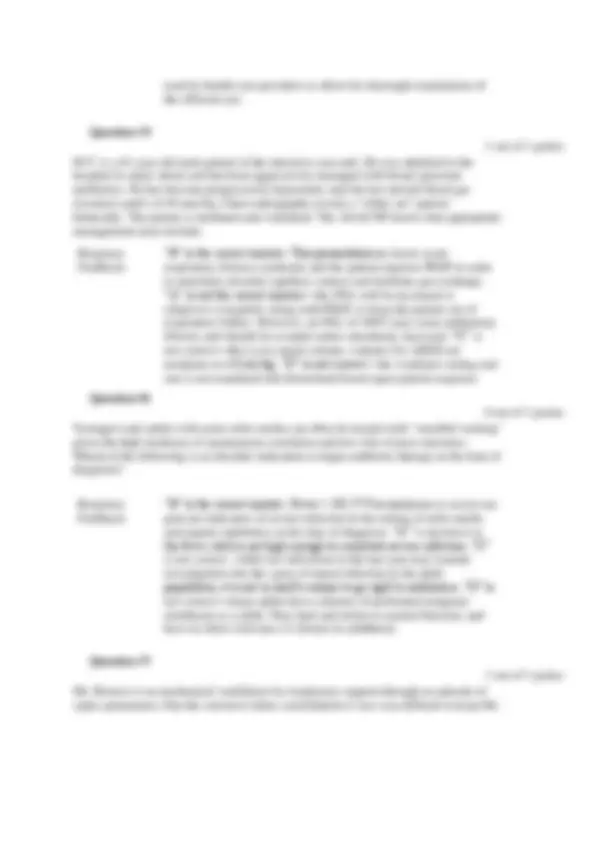
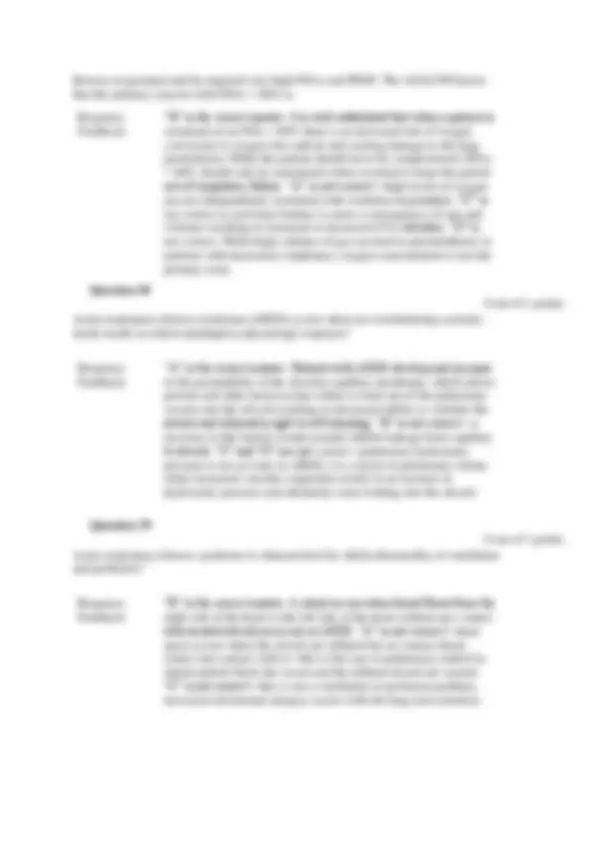
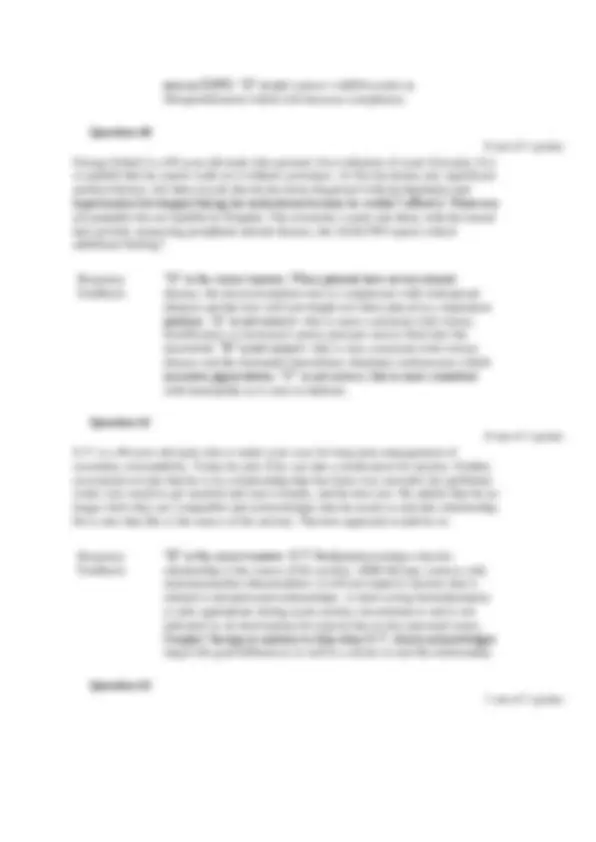
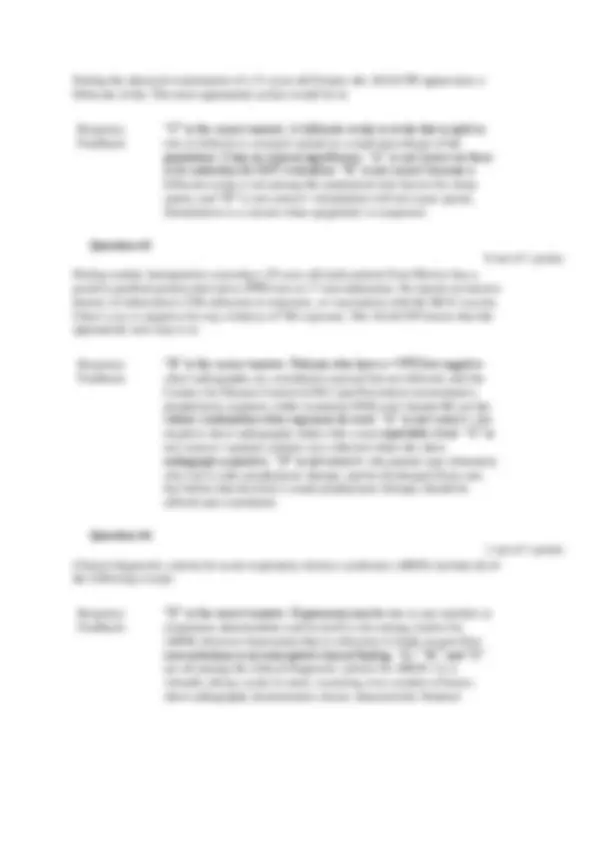
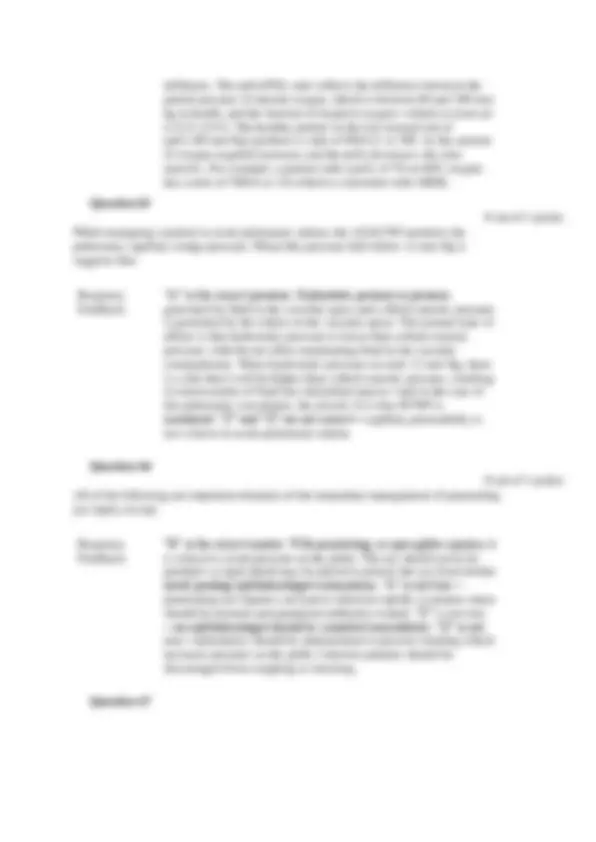
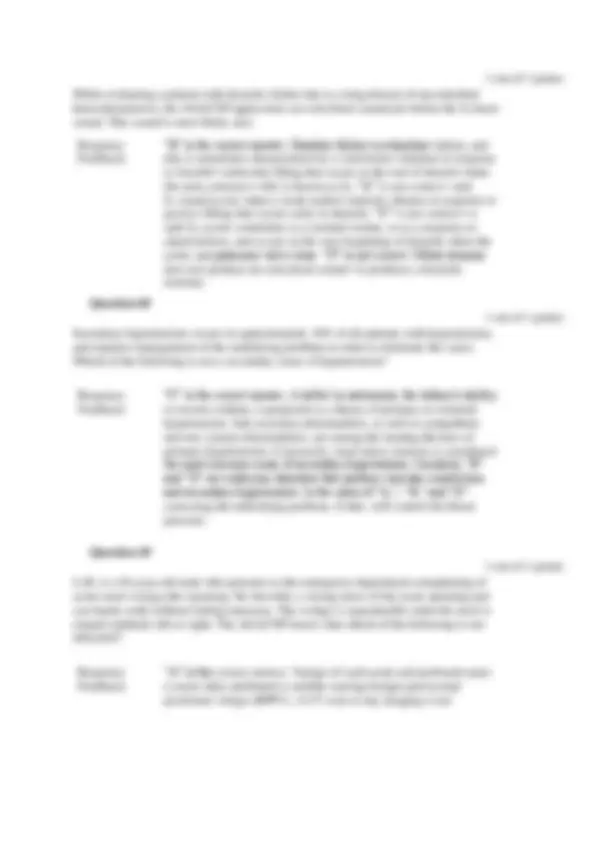
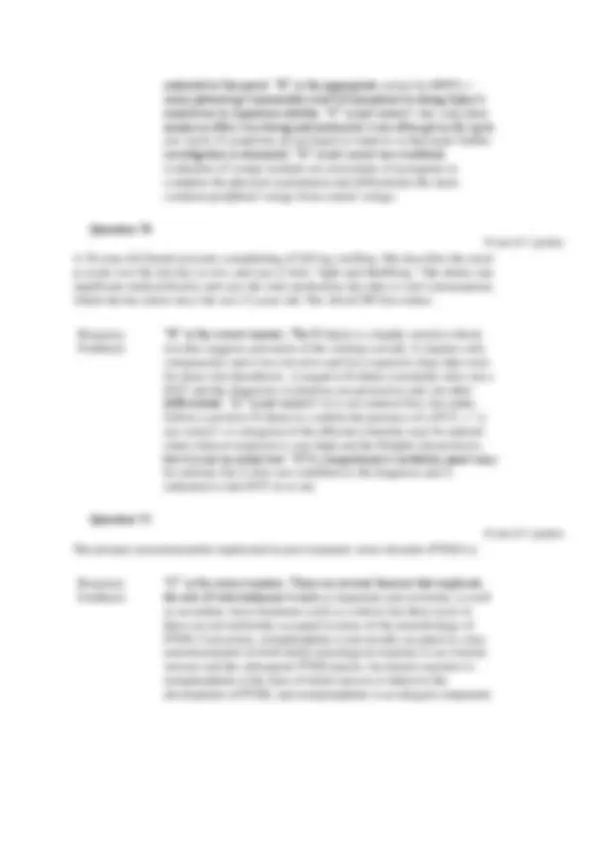
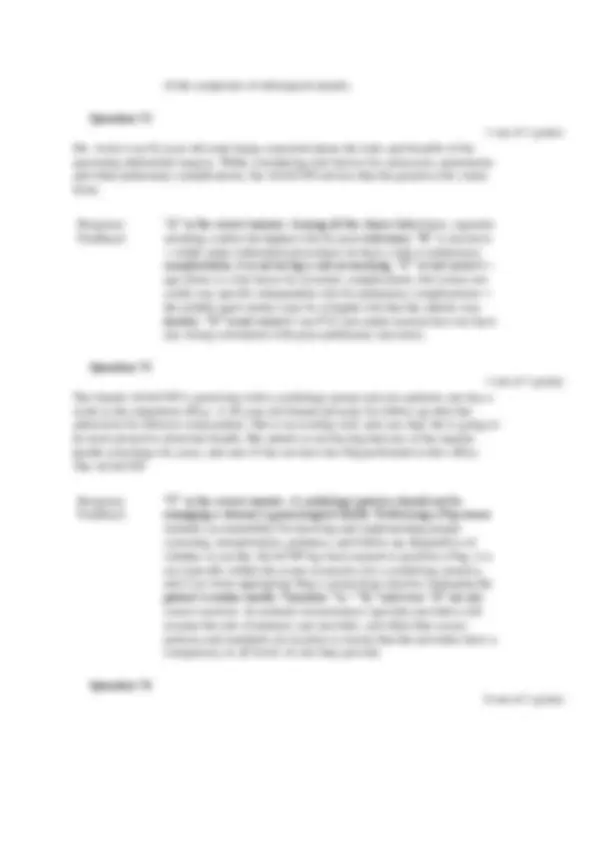
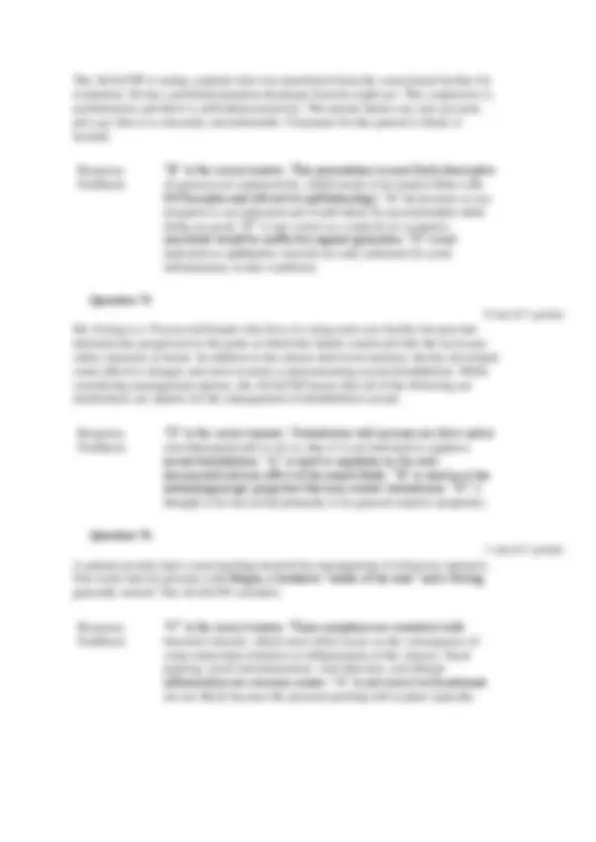
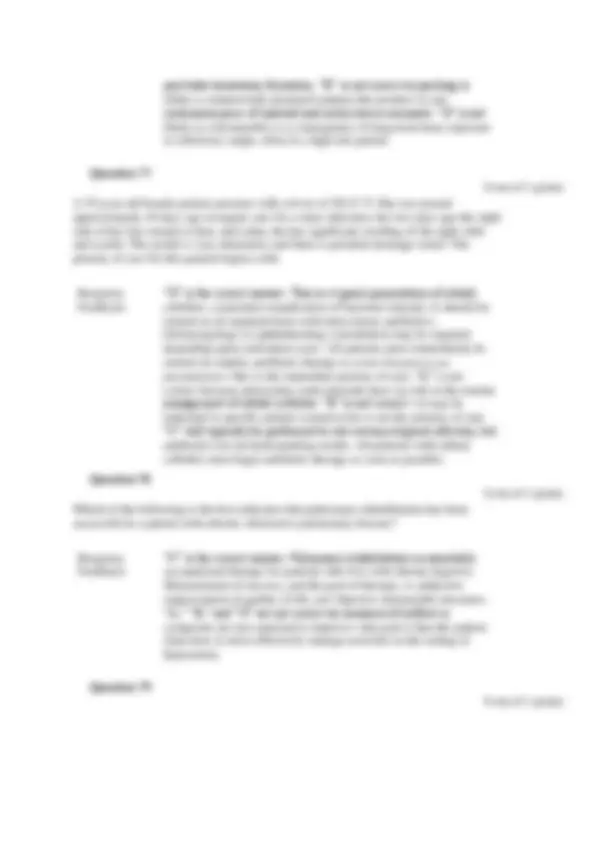
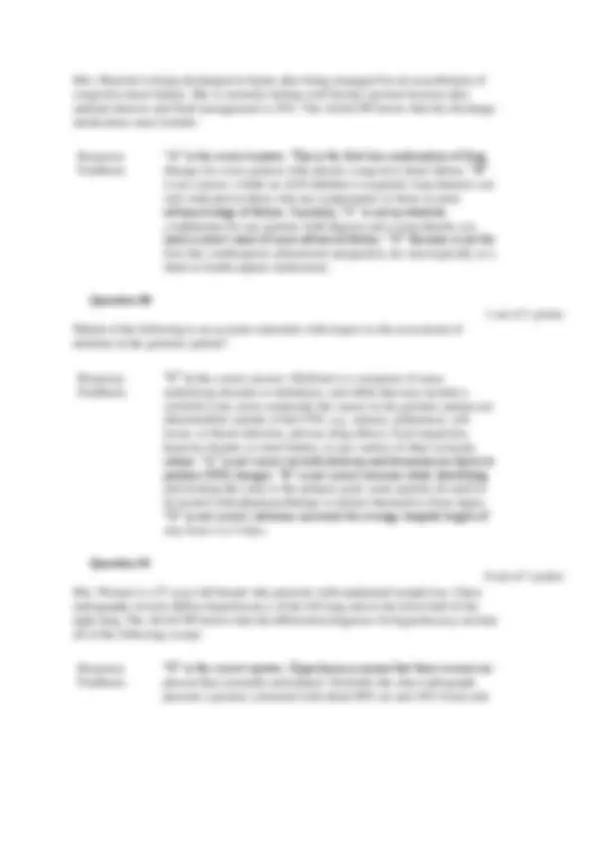
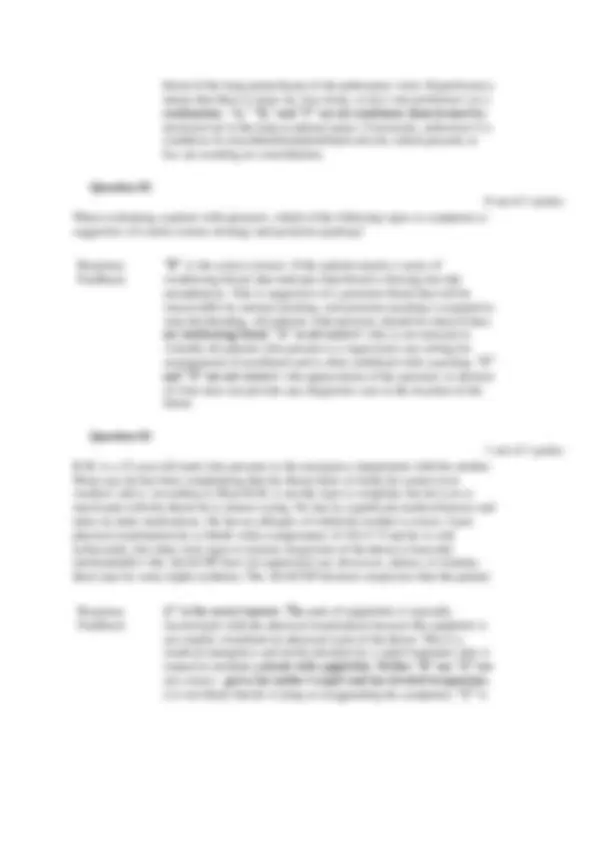
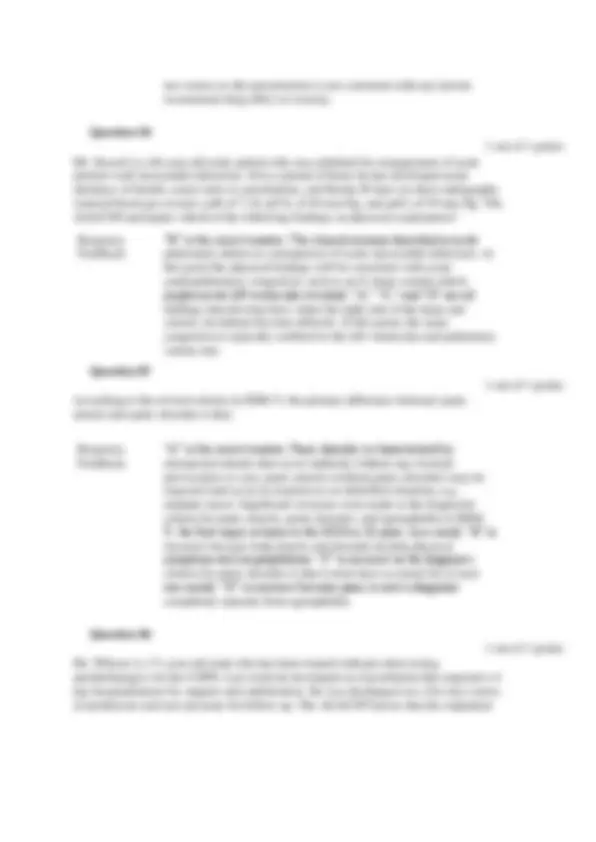
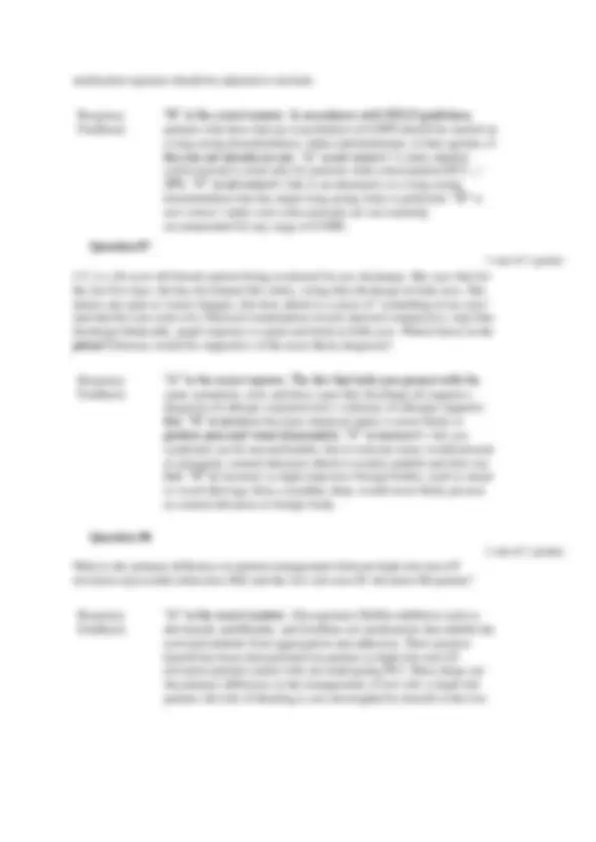
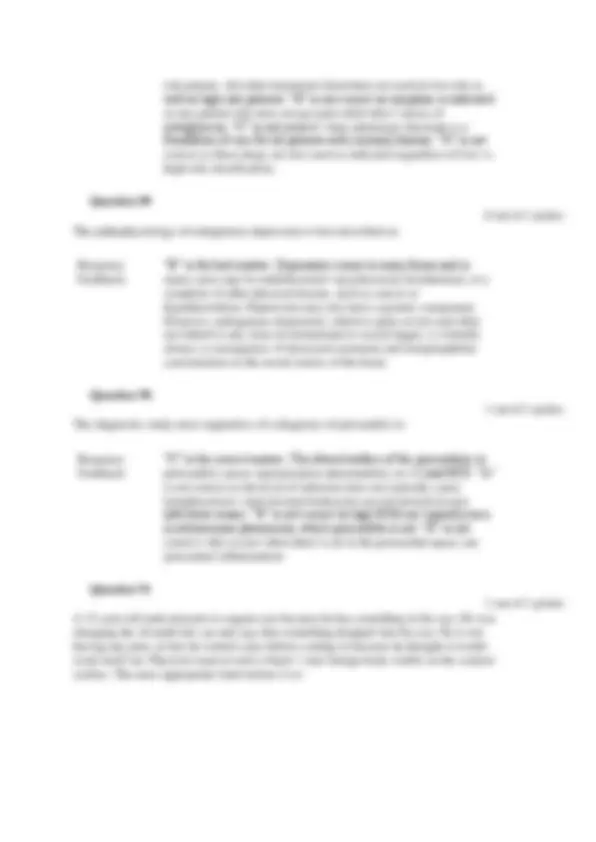
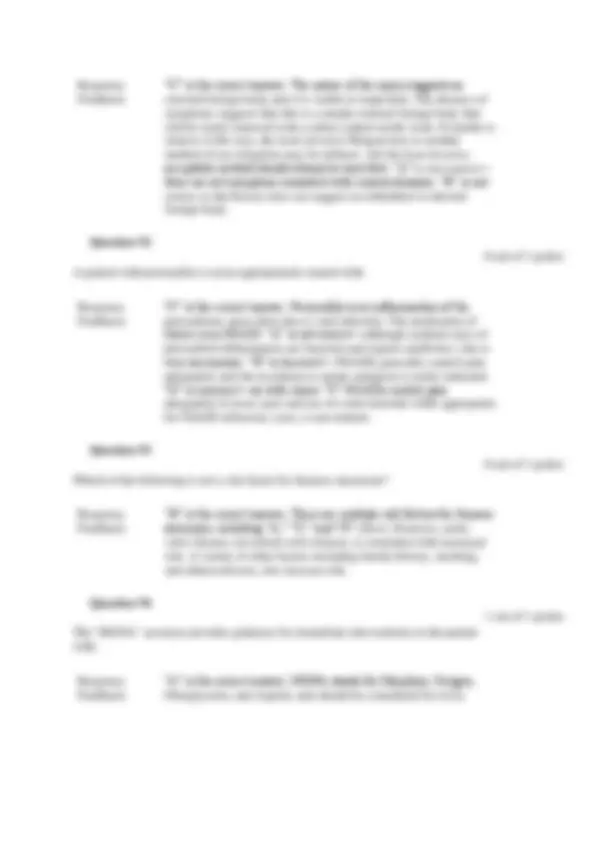
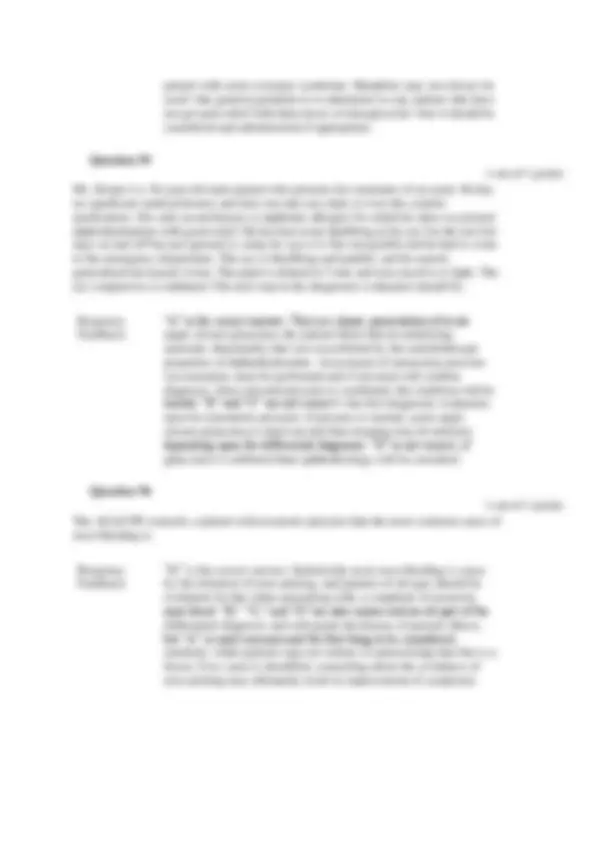
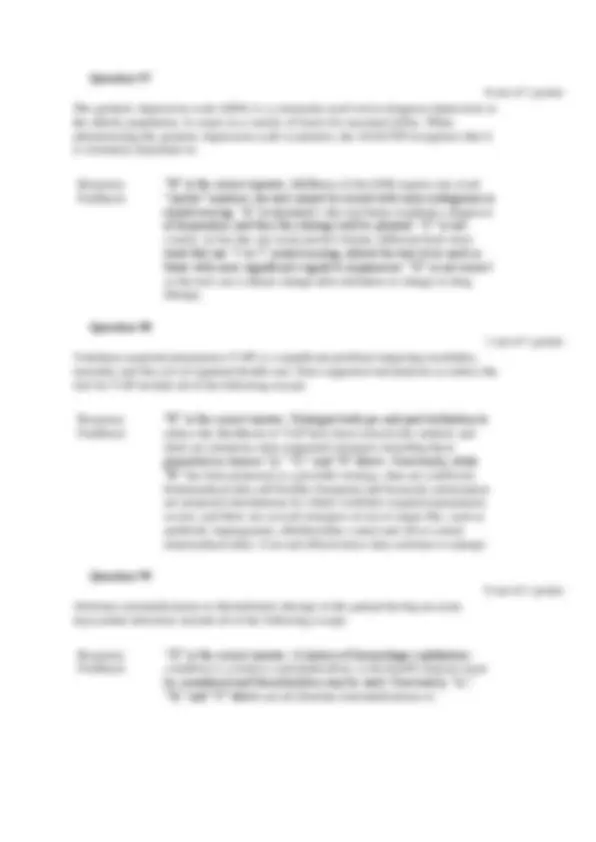
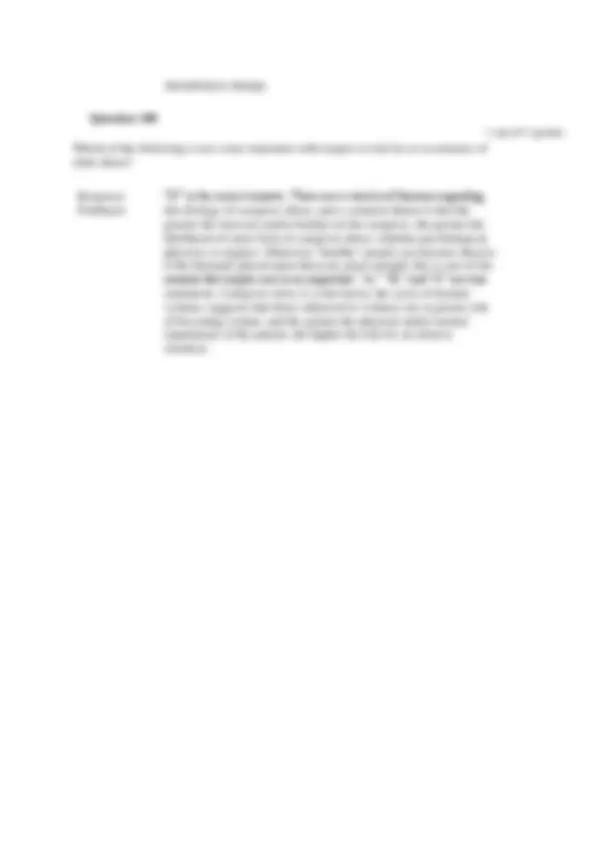


Study with the several resources on Docsity

Earn points by helping other students or get them with a premium plan


Prepare for your exams
Study with the several resources on Docsity

Earn points to download
Earn points by helping other students or get them with a premium plan
Community
Ask the community for help and clear up your study doubts
Discover the best universities in your country according to Docsity users
Free resources
Download our free guides on studying techniques, anxiety management strategies, and thesis advice from Docsity tutors
NURS 6550 MIDTERM EXAM QUESTIONS AND ANSWERS
Typology: Exams
1 / 43

This page cannot be seen from the preview
Don't miss anything!




































Question 1 1 out of 1 points The AGACNP is caring for a patient who is quite ill and has developed, among other things, a large right sided pleural effusion. Thoracentesis is sent for pleural fluid analysis. While evaluating the fluid analysis, the AGACNP knows that a fluid identified as a(n) is the least worrisome type. Response Feedback: “A” is the correct answer. A transudate is essentially just water and can occur as a consequence of increased hydrostatic pressure in the pulmonary vessels. It typically implies that the some condition has produced an imbalance in colloid-hydrostatic pressures, such as CHF or hypoalbuminemia. While it can represent a serious problem, it may also represent a transient imbalance. Conversely, “B” is not correct as an exudate has more protein in it and implies a condition characterized by protein leaking from vessels, such as a malignancy or some serious systemic stressor. “C” is not correct—a chyliform effusion is characterized by fat and indicates a pathology causing massive triglyceride degradation. “D” is not correct as a hemorrhagic effusion is blood and typically means traumatic injury. Question 2 1 out of 1 points Differentiating vertigo from near-syncope and ataxia is one of the goals of history-taking when a patient presents as “dizzy.” The AGACP knows that vertigo is the problem when the patient reports the primary symptom as: Response Feedback: “A” is the correct answer. Dizzy is a layperson’s term and can mean many different things to patients and health care providers. When the patient identifies the primary symptom as a sense of spinning this supports vertigo, which is usually an inner ear problem. This versus ataxia which is neurologic or near-syncope which may be cardiac, neurological, or neurocardiogenic. “B” is not correct—this may occur with vertigo, but when it is the primary symptom it is most likely ataxia and neurological causes should be considered. “C” is not correct as coincident nausea is not specific and can occur with any of these complaints. “D” is not correct as it is also not specific; while ataxia cannot occur when supine near-syncope can.
Question 3 1 out of 1 points Mr. Banks has been admitted for surgical resection of a metastatic tumor, during surgery it is discovered that he has widespread, diffuse metastasis throughout the abdomen. Surgery is no longer an option, and his oncologist says that chemotherapy is unlikely to produce any meaningful benefit. Mr. Banks is concerned that his sons will not support a transfer to comfort care. The AGACNP advises that he: Response Feedback: “B” is the correct answer. If there is any concern about disagreement among family members, or any concern at all that a patient’s wishes will not be carried out, the best action is to ensure that there is a clearly defined legally executed document. “A” is not correct. Living wills are not legally enforceable documents and when dissention arises among family members they may not be carried out. “C” is not correct - while the patient should arrange for his care as long as he is capable of doing so, if questions arise at such a time that he is not capable of answering his next of kin will need to do so. “D” is not correct -- identifying the proxy is not enough without assigning legal rights and responsibilities. While “A,” “C,” and “D” should all be done and will support his care, the only way to ensure that one’s wishes are carried out is to ensure that a legally enforceable direction is in place. Question 4 Mr. Wilkerson is a 77-year-old male who is being evaluated and treated for his cardiogenic pain. His vital signs are as follows: Temperature of 99.1° F, pulse of 100 bpm, respirations of 22 bpm, and blood pressure of 168/100 mm Hg. A 12 - lead ECG 1 out of 1 points reveals deep ST segment depression in leads V 3 - V 6. The AGACNP recognizes which of the following as a contraindication to rTPA therapy? Response Feedback: “D” is the correct answer. rTPA is not indicated in patients with ST segment depression; this is not a ST elevation MI. “A” is not correct as age > 80 is a relative contraindication. “B” is not correct as a temperature of 99.1° F is an expected response to myocardial necrosis, and “C” is not correct—the blood pressure is not prohibitive until > 180/110 mm hg.
you that he is really going to quit smoking this time. He acknowledges that he has been "sneaking" cigarettes in the hospital for two days, but he has established a timeline to decrease the number of cigarettes daily. According to his plan his last cigarette will be the last day of the month. This patient’s behavior is consistent with which stage of the Transtheoretical Model of Change? Response Feedback: “C” is the correct answer. The Transtheoretical model of change is characterized by 5 stages. “A” is when the patient has no intention to make a change. “B” is when the patient is intending to make a change in the next 6 months. “C” is when the patient is ready to take action or has already taken some action, as this patient has in establishing his plan to quit by the end of the month. “D” is the overt action that attains a criterion sufficient to reduce disease risk—in this patient the action stage would be characterized by actual smoking cessation. The final phase, not presented in the answer choices here, is maintenance. Question 6 Certain subgroups of the elderly population are at an increased risk for rapid 1 out of 1 points deterioration and long-term care placement. Which of the following is not considered a high risk factor for long term care placement? Response Feedback: “A” is the correct answer; men are at higher risk for long-term care placement than women. In addition to male gender, other risk factors include age over 80, living alone, bowel or bladder incontinence, history of falls, dysfunctional coping, and intellectual impairment. Question 7 P.M. is a 71 - year-old gay male patient who presents as an outpatient for evaluation of 1 out of 1 points increasing shortness of breath. The diagnostic evaluation ultimately supports a diagnosis of community acquired pneumonia. The AGACNP appreciates right middle lobe consolidation on chest radiography. Pending sputum cultures, empiric antibiotic therapy must be initiated to cover which organism? Response “D” is the correct answer. This patient presents from the outpatient
Feedback: population where the most common cause of pneumonia is Streptococcus pneumoniae , and is the primary treatment target for any patient being treated empirically. “A” is not correct—while the patient’s sexual orientation is offered in the provided history, there is no indication that he has HIV/AIDS or any other condition characterized by immunosuppression that would increase his risk for this organism. “B” is not correct, as this organism is not typically seen in the outpatient population without specific risk, e.g. immunosuppression or chronic ventilator therapy. “C” is not the correct answer as this organism is not likely absent specific risk such as instrumentation or known colonization. Question 8 Which of the following is the greatest risk factor for vascular dementia? 0 out of 1 points Response Feedback: “B” is the correct answer. Vascular dementia is a consequence of vascular disease, and is more likely to occur in patients with risk factors for target organ damage, such as hypertension, dyslipidemia, and diabetes. “A” is not a distinct risk factor for vascular dementia; it is a risk for Alzheimer’s dementia. “C” likewise increases risk for Parkinson’s dementia, but does not present a risk for vascular dementia. “D” is not a risk factor for vascular dementia. Although there may be some familial risk for certain vascular diseases that may lead to vascular dementia, there is no clear familial tendency for this type of dementia. Question 9 J.R. is a 55 - year-old male who presents for a commercial driver’s license physical 1 out of 1 points examination with a blood pressure of 170/102 mm Hg. He has no medical history and is without complaint. Which of the following findings constitutes hypertensive urgency? Response Feedback: “A” is the correct answer. According to the Joint National Committee (JNC) report, hypertensive urgency is described as hypertension in the setting of progressive target organ damage, such as renal involvement with protein leaking, left ventricular hypertrophy, or retinal changes. “A” is not correct—the headache may or may not be relevant, but because there are many non- hypertension causes, a headache alone does not constitute target organ damage. “C” is not correct—it may indicate carotid plaque, but this is not a consequence of hypertension. “D” is not correct as a 1+ palpable pulse may be a normal finding--it must be taken in the
Response Feedback: “B” is the correct answer. The D-dimer is a highly sensitive serology and is the least invasive mechanism by which a pulmonary embolus may be ruled out; a negative D-dimer virtually eliminates pulmonary embolus from the differential diagnosis. “A” is not correct—while it can be used to make the diagnosis it is more invasive and less specific than other options. “D” is not correct—there is no indication that the patient is on warfarin, and in any event it would not be used to rule in or out pulmonary embolus “C” is not accurate when after surgery, as it will be positive after surgery. Question 13 Mr. Nixon is being treated with unfractionated heparin infusion for acute pulmonary embolus. In order to avoid a potentially fatal complication of heparin infusion, the AGACNP monitors: 1 out of 1 points Response Feedback: “D” is the correct answer. An uncommon but potentially serious consequence of heparin infusion is heparin-induced thrombocytopenia. Some patients make autoantibodies in response to exogenous heparin that activate their own platelets. When this occurs, heparin must be immediately discontinued and thrombin inhibitors started. “A” is not correct—this is not affected by heparin, but is monitored in those on Coumadin. “B” is not correct—this is also unaffected by heparin, but monitored on Coumadin. “C” is not correct—this is monitored to assess therapeutic efficacy, but not for complications. Question 14 1 out of 1 points While assessing a patient with a known psychiatric history, the AGACNP knows that the primary difference between a psychotic and neurotic disorders is: Response Feedback: “B” is the correct answer. Patients with psychotic disorders are characterized by a distinct alteration in their perception of reality which may be manifest by visual or auditory hallucinations or impaired thought processes. Neurotic disorders, while many times very serious, are seen in patients who remain aware and interactive with the reality. “A” is incorrect as neurotic disorders may be characterized by a tendency or actual act of harm, such as the self- mutilating actions classic of a borderline personality, suicide by a
depressed patient, or even murder or torture committed by an antisocial personality. While dangerous, none of those disorders include a dis-connect from reality as part of the presentation. “C” is incorrect as antipsychotic medications are used to manage a variety of neurotic disorders such as depression or oppositional defiant disorder. “D” is incorrect as lack of conscience and remorse is typical of antisocial personalities. Question 15 0 out of 1 points L.T. is an 85-year-old male who is admitted for evaluation of profound diarrhea that has produced significant dehydration. He also complains of being very tired lately, and feeling like he is going to vomit all of the time. His vital signs are significant for a pulse of 41 b.p.m. and a blood pressure of 90/60 mm Hg. A gastrointestinal evaluation including stool for blood, white blood cells, and ova and parasites is negative. He insists that he has not started any new medications or made any diet changes; the only thing new is that he got new eye drops for his glaucoma. The AGACNP correctly assumes that his new eye drops are: Response Feedback: “B” is the correct answer. The accelerated GI motility and bradycardia are cholinergic adverse effects. Ophthalmic medications are readily absorbed into systemic circulation. All of these medications are used to treat glaucoma and may cause class-related adverse effects, but cholinergic drops are the only ones shown that will slow heart rate and accelerate GI motility. Question 16 1 out of 1 points Janice is a 19-year-old female who presents to the emergency department via ambulance. She is pale, diaphoretic, agitated, and convinced she is having a stroke. Her vital signs include a temperature of 98.9° F, pulse of 114 beats per minute, respirations of 32 breaths per minute, and a blood pressure of 110/74 mm Hg. Diagnostic evaluation is negative and Janice is diagnosed with an acute panic attack. The initial treatment of choice is: Response Feedback: “A” is the correct answer. A panic anxiety attack requires immediate intervention with a short acting benzodiazepine for immediate symptom control. A calm environment would be helpful, but is not adequate alone to manage acute episodes characterized by physical symptoms. Oxygen is not indicated in the absence of organic
AGACNP determines that he has experienced persistent, excessive anxiety and worry almost every day for more than one year. What other aspect of Mr. Owen's psychosocial history would be required to made a diagnosis of generalized anxiety disorder? Response Feedback: “D” is the correct answer. Generalized anxiety disorder (GAD) is an axis I disorder according to DSM-V. Diagnostic criteria require that the patient report both excessive anxiety and worry, and difficulty controlling that worry, for more days than not in the last six months. These two cardinal requirements are accompanied by three of at least six other findings, which may or may not include choices “A” through “C”; so while sleep disturbances, difficulty concentrating and muscle tension may or may not occur, excessive anxiety and worry and difficulty controlling that worry are required for the diagnosis. Question 20 0 out of 1 points Kevin T. is a 49-year-old male who is being discharged after hospitalization for an acute inferior wall myocardial infarction. This is his first hospitalization and his first chronic medical diagnosis. Aside from his elevated cardiac isoenzymes and troponins, his laboratory profile was essentially within normal limits. The only apparent cardiac risk factor is an LDL cholesterol of 200 mg/dL. Initiating an HMG-CoA reductase inhibitor is an example of which level of prevention for Kevin? Response Feedback: “C” is the correct answer. Controlling his LDL after a myocardial event is about trying to prevent further events or deterioration. “A” is not correct as primary prevention is about preventing disease— appropriate exercise in a healthy patient is primary prevention. “B” is not correct as secondary prevention is about screening for asymptomatic disease and intervening before disease develops— routine cholesterol screening that reveals an elevated before an MI would be secondary prevention. “D” is not correct as there is no “restorative” level of prevention. Question 21 1 out of 1 points You are evaluating a patient who has been admitted to the emergency room after being arrested for starting a fight in a local sports' bar. The patient is now being cooperative, but reports that he has been in treatment for PTSD for months. He has been prescribed fluoxetine but has not noticed any improvement in symptoms, and now has been arrested for violence. The AGACNP knows that the next step in medication management is likely to include:
Response Feedback: “A” is the correct answer. While SSRIs, beta adrenergic antagonists, and even centrally acting antiadrenergic agonists (clonidine) are all used as first line agents depending upon symptom presentation, patients who have more severe symptoms and do not respond to initial treatments often require management with atypical antipsychotics. This patient has been treated with an SSRI, reports no improvement, and has been arrested for his behavior; these circumstances are a clear indication for escalation to the nest level of therapy. Question 22 1 out of 1 points Mrs. Salter is an 81-year-old lady who presents for evaluation of near-syncopal episodes. Her 12-lead ECG, complete blood count, and comprehensive metabolic panel are all essentially normal. A urinalysis shows some trace protein but is otherwise normal. A 24- hour rhythm monitor demonstrates rare premature ventricular contractions. Mrs. Salter has been in good health and had her first episode at her aerobics class. She only gets lightheaded when she exerts herself. Her heart auscultates for a grade III/VI systolic crescendo-decrescendo murmur at the second intercostal space, right sternal border. The AGACP considers that the likely cause of the syncope is: Response Feedback: “C” is the correct answer. This is the classic murmur of aortic stenosis, which impedes cardiac output and as it progresses will produce a symptomatic decrease in carotid perfusion. “A” is not correct as there is no sign or symptom of seizure activity. “B” is not correct—the rare PVC is not likely to cause syncope. “D” is not correct—a blood pressure is not given and the proteinuria could come from any variety of causes. 0 out of 1 points A patient with anterior epistaxis has been treated with 20 minutes of direct pressure to the cartilaginous portion of the nose. Following pressure the patient is instructed to gently blow the nose. Expected findings in the patient who has been successfully treated include all of the following except a: Response Feedback: “C” is the correct answer. If bleeding is successfully stopped with 20 minutes of directed pressure, there will be residual blood and clot formation. This is evacuated either by gentle suction or having the patient gently blow. Residual blood and formed clot may present as a sudden gush of dark blood or discharge with or without a clot— these are all typical expected findings. However, if bleeding is not stopped, it will continue as a bright red steady trickle. When this
son says she is generally very happy as long as there is no change in her day to day routine. This history is most consistent with which form of dementia? Response Feedback: “C” is the correct answer. Alzheimer’s dementia is statistically the most common form of dementia and is characterized by a long trajectory that progresses to include confabulation. Additionally, patients with this form of dementia are very reliant upon routine and may be distressed when it is disrupted. “A” is not correct; Lewy body dementia characteristically progresses much more quickly and produces an angry demeanor. “B” is incorrect because vascular dementia typically produces a more depressive affect and is not characterized by confabulation; additionally, patients with vascular dementia often have a medical history consistent with vascular risk factors. “D” is not correct as there is no apparent history of Parkinson’s disease. Question 27 Mrs. Radovich is an 80 - year-old female with a variety of chronic medical conditions 1 out of 1 points which are reasonably well controlled. She generally enjoys a good quality of life and is active with her family. Today her only concern is that she is having problems with her vision. She notices that while trying to look at pictures of her great grandchildren she can’t seem to focus on their faces. She also reports increased trouble reading—she cannot seem to see the words that she is looking at, and her reading glasses do not help. Further evaluation of Mrs. Radovich should include assessment with: Response Feedback: “D” is the correct answer. An Amsler grid is used to assess central vision and is used to assess symptoms of macular degeneration, an age-related disease that decreases central vision. “A” is not correct, a slit lamp assesses the anterior chamber of the eye and does not especially help in evaluation of macular symptoms. “B” is not correct as this assesses visual acuity and would not be especially helpful with the complaint is loss of central vision. “C” is not correct —a Wood’s lamp is an alternate light source used to visualize corneal abrasions. Question 28 0 out of 1 points R.J. is a 55-year-old female who presents with acute onset left sided facial pain and an inability to move the left side of her face. She cannot smile, raise her eyebrow or even close her left eye, The immediate approach to this patient should include: Response “A” is the correct answer. This is the classic presentation of Bell’s
Feedback: palsy, and rapid administration of corticosteroids can decrease the intensity and duration of symptoms, as well as reduce the likelihood of residual pain. “B” is not indicated; it does not contribute to the diagnosis. “C” may be used as there is a theory that herpes virus causes Bell’s palsy, but this is equivocal and not uniformly practiced. “D” may become necessary at some point to prevent corneal abrasion but the immediate approach should be corticosteroids. Question 29 A 78 - year-old male present for a physical examination. He has no discomfort or 1 out of 1 points complaints other than a general decrease in vision, but it helps when he puts things under a bright light to read. He admits that while driving at night the streetlights appear to be a bit distorted and his night vision is pretty poor. Given the likely diagnosis, the AGACNP expects which of the following physical findings? Response Feedback: “C” is the correct answer. This scenario is consistent with cataracts, a common abnormality seen in older adults. The presence of the cataract diminishes the red reflex and ultimately will obliterate it. “A” is not correct, injected conjunctiva are more consistent with inflammation. “B” is not correct—a sluggish pupil response may occur in response to a variety of conditions, including drug toxicities and poisonings, neurological, or ocular disease, but not with cataracts. “D” is not correct; white spots in the macula is most often suggestive of macular degeneration. Question 30 0 out of 1 points Jason is a 46-year-old male who is being managed for sepsis. He has HIV/AIDS and has had a prolonged hospitalization characterized by a variety of complications. He was extubated 3 days ago but continues gastric decompression with a nasogastric tube(NGT), total parenteral nutrition and antibiotic therapy via a central venous catheter, and urinary drainage via a Foley catheter. He continues to demonstrate consistent low grade fevers but all points of insertion of his tubes are normal to inspection, a chest radiograph demonstrates improvement of his pneumonia, and his urinalysis shows no bacteria, leukocytes, or nitrites. The AGACNP should next order: Response Feedback: “C” is the correct answer. The incidence of bacterial sinusitis is significantly higher in patients with AIDS as compared to the general population and the long term NGT is a risk factor for sinus infection. A maxillofacial CT scan should be considered in any patient with AIDS to rule it out in the setting of persistent fever,
bleeding. She appears to have stabilized hemodynamically, but today she had a temperature of 101.9° F and chest radiography demonstrates a diagnosis of pneumonia. The AGACNP knows that the diagnostic evaluation for hospital acquired pneumonia for all patients must include: Response Feedback: “A” is the correct answer. At a minimum, the American Thoracic Society/Infectious Disease Society of America (ATS/IDSA) guidelines suggest induced sputum, arterial blood gas, and blood cultures for all patients with nosocomial pneumonia (acquired after a hospitalization of > 72 hours). “B” is not correct—neither viral cultures nor CT of the chest are routinely mandated for all patients, although they may be necessary in selected circumstances. “C” is not correct thoracentesis is only indicated for large effusions or any effusion in which the patient appears toxic. Similarly, bronchoscopy is not routinely indicated but may be useful in some circumstances. “D” is not correct as thoracentesis, as previously noted, is not routinely indicated. Question 34 0 out of 1 points Most psychosocial theories of aging center around the core concept that successful aging requires acceptance of a series of changes or losses that predictably occur later in the life span. The theory that specifically addresses coming to terms with the inevitability of death is known as: Response Feedback: “B” is the correct answer. Levinson’s work has been widely interpreted, and it is the only one of the developmental theories that specifically calls upon the older adult to accept the inevitability of death in order to achieve emotional harmony later in life. Other theorists, including those in “A,” “C,” and “D” focus more on the required adjustments to change in physical appearance, change in income, change in relationships, and loss of professional identity. Question 35 All of the following conditions are risk factors for pulmonary embolus except: 0 out of 1 points Response Feedback: “C” is the correct answer. A factor VIII deficiency is hemophilia, in which patients have a decreased ability to clot and are at risk for pathologic bleeding. Conversely, “A” and “D” are not correct as protein C and protein S, activated by the products of clotting, ultimately inhibit the clotting cascade. Deficiencies in protein C and S result in an inability to inhibit clotting and are at risk for
pathologic clotting. Factor V is a clotting factor that is inhibited by the activated protein C and protein S complex. “B” is not correct— when patients have a mutation of factor V, it is insensitive to the inhibiting properties of protein C and S and clotting cannot be stopped appropriately—resulting in increased risk of clotting. Question 36 1 out of 1 points A patient is diagnosed with acute descending aortic aneurysm and hypertension should be immediately started on which medication pending surgical evaluation? Response Feedback: “A” is the correct answer. Beta adrenergic antagonists decrease the force of contraction therefore decreasing shear force exerted on the dissection. “B” is not correct, intravenous vasodilators are not used initially although are a second option to reduce systolic blood pressure but. “C” and “D” are not correct as other medical management strategies have not demonstrated improved outcomes. Ultimately these patients will require surgical intervention. Question 37 Jason is a 27-year-old with a long history of intermittently controlled asthma. He is currently prescribed Advair daily with albuterol as needed for symptoms. Today he 0 out of 1 points presents to the emergency department with cough and wheezing and difficulty catching his breath. His FEV 1 is 51% at the time of presentation. He is given alternating albuterol and ipratropium nebulizer treatments along with oral prednisone. After one hour his FEV 1 has increased 65%. The appropriate disposition for Jason at this point is: Response Feedback: Question 38 “B” is the correct answer. The EPR-3 guidelines for management of asthma in the urgent and emergency care setting indicate that if the FEV 1 remains below 70% after one hour of emergency care that the patient should be admitted. “A” is not correct—he does not have an indication for intubation as his FEV 1 is improving and is not approaching the 40% that would indicate intubation. “C” is not correct—he has already been assessed and treated for one hour and at this point admission is indicated. “D” is not correct—he cannot be discharged to home unless his FEV 1 is > 70% A patient in the intensive care unit suddenly becomes tachypneic and dyspneic. The physical examination reveals pale, cool, clammy skin and an arterial blood gas demonstrates hypocapnea and hypoxia. Pulmonary artery pressure demonstrates a pattern consistent with obstructive shock. The AGACNP knows that which of the 1 out of 1 points
Question 41 0 out of 1 points “C” is the correct answer. Alzheimer’s dementia is statistically the most common form of dementia and is characterized by a long trajectory that progresses to include confabulation. Additionally, patients with this form of dementia are very reliant upon routine and may be distressed when it is disrupted. “A” is not correct; Lewy body dementia characteristically progresses much more quickly and produces an angry demeanor. “B” is incorrect because vascular dementia typically produces a more depressive affect and is not characterized by confabulation; additionally, patients with vascular dementia often have a medical history consistent with vascular risk factors. “D” is not correct as there is no apparent history of Parkinson’s disease. Response Feedback: “A” is the correct answer. Aricept is a cholinesterase inhibitor and works by increasing levels of acetylcholine. Increased acetylcholine may produce systemic activation of the parasympathetic system resulting in increased gastrointestinal (GI) motility; vomiting and diarrhea are not uncommon affects. “B” is not likely as cholinergic activity will slow the heart rate and calm the central nervous system. “C” is incorrect as cholinergic activation will increase salivation. “D” is incorrect as weight gain is not a likely consequence of a drug that increases GI motility. Question 42 What is the primary purpose of using eye ointments or lubricants to patients under general anesthesia, on paralytics, or in long-term comatose states? 1 out of 1 points Response Feedback: “B” is the correct answer. Patients in these circumstances are vulnerable to a decrease in natural tear production and are at risk for iatrogenic corneal abrasion. and lubricants are integral to prevention. “A” is not correct as the retina is within the eye fundus and not affected by topical lubrication. “C” is not correct because ophthalmic pH is not a primary impact of drying—pH abnormalities are more likely with chemical irritations. “D” is not correct because lid mobility is a muscular action and not effected by drying or lubricants. Question 43 When reading a 12 - lead electrocardiogram, the AGACNP knows that all 12 leads are required to provide: 1 out of 1 points Response “C” is the correct answer. Each lead provides a different perspective
Feedback: from which to view the amplitude and direction of electrical activity as it moves through the heart in terms of length, width, and depth; the inferior, lateral, and anterior walls respectively. “A” is not correct because QRS axis is determined from the inferior and lateral leads only. “B” is not correct, both atrial and ventricular abnormalities can be determined from a lesser number of select leads. Similarly “D” is not correct as it does not take 12 leads to assess contraction and relaxation. Question 44 A 49-year-old male presents for evaluation of chest tightness. It has happened before, but he just ignored it and it went away. Today he just could not ignore it anymore. He 0 out of 1 points has always enjoyed good health and says he has never been told that he has any chronic medical conditions like high blood pressure or diabetes. A 12-lead ECG demonstrates changes consistent with inferior wall ischemia. Both his symptoms and inferior wall changes improve with the administration of sublingual nitroglycerin. Consistent with ACS protocol, this patient’s assessment is consistent with: Response Feedback: “A” is the correct answer. ACS protocol categorizes acute myocardial pain as either unstable angina/non-ST elevation MI (low or high risk), and ST elevation MI. A non-ST elevation (subendocardial) MI is treated in the same manner as unstable angina and the only question is whether the patient is at high risk or low risk —this is determined by an objective assessment including tools like TIMI and GRACE scores. An ST elevation MI is an infarct that spans the entire thickness of the myocardium and warrants fibrinolytics if the patient is a candidate. This patient presents with inferior wall ischemia which is unstable angina. Therefore the only question is whether he is high or low risk. His absence of medical history, dysrhythmia, instability or any other abnormalities implies low risk. He will be treated conservatively and referred for outpatient long term management of coronary artery disease. Question 45 Mr. Rosen is a 49-year-old male who is being managed for an acute myocardial infarction. He develops significant shortness of breath at rest and coarse rales 2/3 up bilaterally. The AGACNP suspects acute pulmonary edema due to papillary muscle 0 out of 1 points rupture and acute mitral valve regurgitation. Which physical finding would support this finding? Response “B” is the correct answer. Murmur assessment requires identification